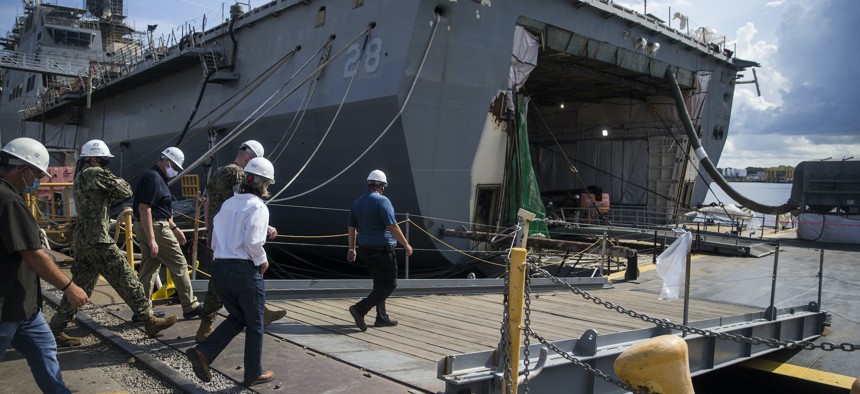
Assistant Commandant of the Marine Corps Gen. Gary L. Thomas recieves a tour of the Huntington-Ingalls Shipyard in Pescagola, Miss, Aug. 13, 2020. U.S. Marine Corps / Sgt. Wesley Timm
Navy: Just One Shipbuilding Option Gets Closer To Desired Fleet
A 3-star clarifies the three paths described in the Navy's recent longterm fleet plan.
While the U.S. Navy's new long-term shipbuilding plan lays out three options, service leaders believe only one of those even comes close to building a fleet that can compete with China, a Navy official said during a Senate hearing Tuesday.
The plan, sent to Congress on April 20, has already been criticized by Republican lawmakers. It is the second for President Joe Biden’s administration, and like the first, it steps away from past submissions. This one provides multiple options for the quantity of ships and funding level for the fleet between 2028 to 2052. Typically, the Navy charts out the specific number of ships it plans to buy and retire each year, as well as the total size of the fleet for those years.
Sen. Josh Hawley, R-Missouri, asked point-blank whether the Navy is confident that each of the three options provided “would allow it to meet the operational requirements for deterring a Chinese fait accompli vis-à-vis Taiwan?”
In response, Vice Adm. Scott Conn, the deputy chief of naval operations for warfighting requirements and capabilities, told Hawley that the Navy has “the most confidence in alternative three,” and less confidence in the other two.
Conn added later that the third option gets the Navy closer to where it wants to be with the fleet.
The plan’s first two options or “alternatives” assume no real budget growth and reflect analysis from last year’s shipbuilding plan, 2022 appropriations, and the 2023 presidential budget proposal, the document says. The third alternative, which is based on the Navy’s Integrated Naval Force Structure Assessment, would require spending an extra $75 billion (in 2022 dollars) between 2028 to 2052; it also assumes that industry will deliver the ships on time and within budget. None of the options reflects the Biden administration’s recent National Defense Strategy.
Sen. Kevin Cramer of North Dakota, the ranking member of the Senate Armed Services Subcommittee on Seapower, echoed previous Republican criticisms about the plan’s approach.
“This year's shipbuilding plan’s choose-your-own-adventure format lacks coherence, and three different outcomes raise more questions than they answer,” he said.
Last week, Conn told reporters that the multiple options in the plan reflect the difficulty of predicting budgets, technological advances, and Chinese and Russian moves. Jay Stefany, who is performing the duties of assistant Navy secretary for research, development, and acquisition, also told reporters at the time that the Navy would want the third option with more ships and funding, but the decision was not up to them.
“As far as the Navy, certainly we would want to have the higher line, but we recognize that there is, you know, the overall administration has a bunch of priorities and where the Navy fits in… is something that Congress and the administration will have to figure out,” he said.
Seapower subcommittee chair Sen. Mazie Hirono, D-Hawaii, asked how practical and realistic the third option is compared to the other two, based on the funding that will be available.
“The fiscal certainty of that option I really can't speak to right now. I can say in terms of where we are today, the answer would be no,” Conn said. “But again, this is starting growth per the shipbuilding plan in 2028 and out, in order to get to the—whether it be three DDGs per year, three frigates per year, three submarines per year, getting into an SSN(X) by the 2040s…I will say there is some uncertainty in that path forward.”




